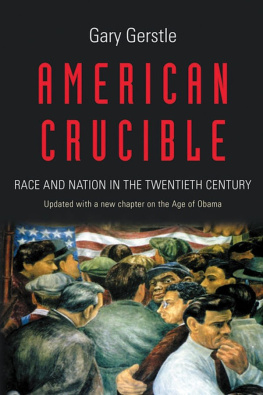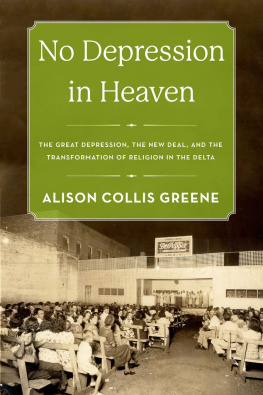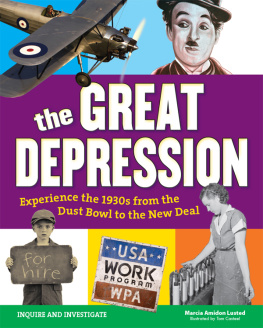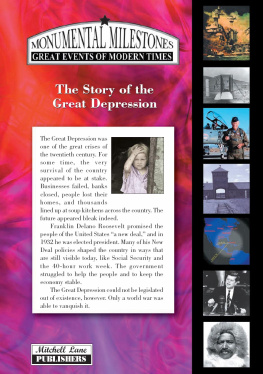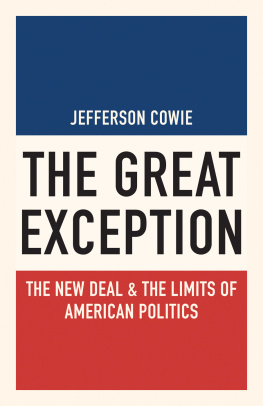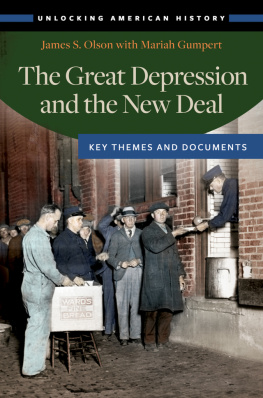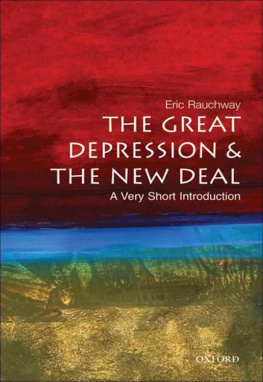Beyond the New Deal Order
POLITICS AND CULTURE IN MODERN AMERICA
Series Editors: Margot Canaday, Glenda Gilmore, Matthew Lassiter, Stephen Pitti, Thomas J. Sugrue
Volumes in the series narrate and analyze political and social change in the broadest dimensions from 1865 to the present, including ideas about the ways people have sought and wielded power in the public sphere and the language and institutions of politics at all levelslocal, national, and transnational. The series is motivated by a desire to reverse the fragmentation of modern U.S. history and to encourage synthetic perspectives on social movements and the state, on gender, race, and labor, and on intellectual history and popular culture.
BEYOND THE NEW DEAL ORDER
U.S. Politics from the Great Depression to the Great Recession
Edited by
Gary Gerstle,
Nelson Lichtenstein,
and
Alice OConnor
UNIVERSITY OF PENNSYLVANIA PRESS
PHILADELPHIA
Copyright 2019 University of Pennsylvania Press
All rights reserved. Except for brief quotations used for purposes of review or scholarly citation, none of this book may be reproduced in any form by any means without written permission from the publisher.
Published by
University of Pennsylvania Press
Philadelphia, Pennsylvania 19104-4112
Printed in the United States of America on acid-free paper
10 9 8 7 6 5 4 3 2 1
A catalogue record for this book is available from the Library of Congress.
ISBN 978-0-8122-5173-9
Introduction
Gary Gerstle, Nelson Lichtenstein, and Alice OConnor
In 1989 when The Rise and Fall of the New Deal Order appeared, the collection of ten historical essays proved notable for two reasons. First, it introduced the concept of a political, socioeconomic order as one of the fundamental building blocks with which historians and social scientists construct and make sense of the American past. In this case, it offered an overarching interpretive framework, a sense of political and economic continuity for the sociopolitical order that began with the election of Franklin D. Roosevelt in 1932 and ended sometime after Ronald Reagans victory in 1980. The volumes editors, Steve Fraser and Gary Gerstle, invited scholars and journalists to consider the New Deal not only as a presidential moment but also as a far larger constructiona combination of ideas, policies, institutions, and electoral dynamicsthat spanned several decades and sustained a hegemonic governing regime. This is a periodization that still pervades our historical understanding of twentieth-century America.
A second notable feature of The Rise and Fall of the New Deal Order is this: although conceived and composed during the administration of Ronald Reagan, arguably the most conservative president since the 1920s, the authors and editors of the volume largely blamed American liberalism for what they considered an ideological and political debacle of the first order. As witnesses to the conflicts that had divided liberals since the tumultuous 1960s, most of these historians thought that if the New Deal order was crumbling, it had been subverted not so much by the rise of a political and cultural Right or by a shift in the contours of the economy, but by the contradictionsideological, political, and racialthat had torn labor-liberalism asunder.
This put the sixties front and center when it came to explaining the decline or outright demise of American liberalism. Although many of the historians who contributed to that 1989 volume positioned themselves to the left of liberalismmost notably, Steve Fraser, Nelson Lichtenstein, Ira Katznelson, Maurice Isserman, and Michael KazinRise and Fall was not inspired by a New Left dismissal of what was then sometimes called corporate liberalism. These historians were genuinely appreciative of the substantial economic and social transformations inaugurated and carried forward by New Deal and Great Society politicians and civil rights and labor leaders. But the sixties are nevertheless privileged in the 1989 book as a distinct political and cultural moment whose successes and failures generated much of the backlash that gave rise to New Right conservatism. While the administration of Ronald Reagan captured and codified much of the political and policy consequence, the sixties were the pivot on which the decline of the New Deal order turned. In the volume, Ira Katznelson asked, Was the Great Society a Lost Opportunity? Jonathan Rieder found the rise of a right-wing populism, which President Nixon called the Silent Majority, emerging out of the racial tumult of that era. Maurice Isserman and Michael Kazin highlighted the pervasive influence of sixties radicalism in triggering both progressive transformations in American culture and the resentfully conservative statecraft of George Wallace, Richard Nixon, and Ronald Reagan. It was left to Thomas Edsall, a journalist, to attempt an assessment of how business and other conservatives shifted economic policy to the right in the 1970s, and even he saw this as largely a product of racially motivated Democratic division rather than a consequence of fundamental alterations in the way an increasingly politicized business elite responded to changes in the shape of global capital. In a point developed more sharply in his later journalistic writing, Edsall regretted the loss of working-class politics as a presumably unifying core of the New Deal Democratic Party, as reflected in the waning influence of organized labor and the rise of a more elite cadre of liberal reformers more committed to a regime of rights and identity politics.
In recent decades, the sixties has been decentered as a pivot point in accounts of late-century political transformations. Those who still subscribe to the notion that there was a New Deal order now tend to see the entire era from the 1930s through the 1960s and early 1970s as one in which the proponents of New Dealstyle social democracy battled their opponents on relatively favorable economic and sociopolitical terms. The Great Society, in this view, is seen as an effort to complete reforms begun in the 1930s and cover segments of the population (above all, African Americans) who had been purposefully excluded from much New Deal statecraft when FDR and northern Democrats made their Faustian bargain with the white South. Informed by the growing historiography of the long social democratic civil rights movement, historians have come to see more continuity than rupture between the class and race-specific aims of the black freedom and allied rights struggles. The 1963 March on Washington, they remind us, was a march for jobs and freedom. Likewise, if the late 1960s and early 1970s are seen as an integral part of the New Deal order, then the rise of a feminist consciousness and its insertion into the worlds of work, family, law, and social policy represents a rejection of the patriarchal ethos that characterized so much of the 1930s New Deal and an effort to expand and recast New Deal reformism as an agent of womens rights and gender equity.



